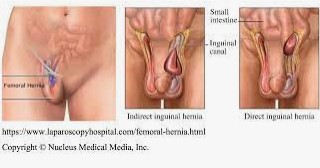 A hernia happens when an internal organ pushes through a weak spot in your muscle or tissue. There are several types of hernia that you can experience including, inguinal hernias, femoral hernias, umbilical hernias and hiatal hernias. If you have a hernia, it is important to treat it quickly.
A hernia happens when an internal organ pushes through a weak spot in your muscle or tissue. There are several types of hernia that you can experience including, inguinal hernias, femoral hernias, umbilical hernias and hiatal hernias. If you have a hernia, it is important to treat it quickly.
The most common forms of hernia are:
- Inguinal hernia: In men, the inguinal canal is a passageway for the spermatic cord and blood vessels leading to the testicles. In women, the inguinal canal contains the round ligament that gives support for the uterus. In an inguinal hernia, fatty tissue or a part of the intestine pokes into the groin at the top of the inner thigh. This is the most common type of hernia, and affects men more often than women.
- Femoral hernia: Fatty tissue or part of the intestine protrudes into the groin at the top of the inner thigh. Femoral hernias are much less common than inguinal hernias and mainly affect older women.
- Umbilical hernia: Fatty tissue or part of the intestine pushes through the abdomen near the navel (belly button).
- Hiatal (hiatus) hernia: Part of the stomach pushes up into the chest cavity through an opening in the diaphragm (the horizontal sheet of muscle that separates the chest from the abdomen).
Other types of hernias include:
- Incisional hernia: Tissue protrudes through the site of an abdominal scar from a remote abdominal or pelvic operation.
- Epigastric hernia: Fatty tissue protrudes through the abdominal area between the navel and lower part of the sternum (breastbone).
- Spigelian hernia: The intestine pushes through the abdomen at the side of the abdominal muscle, below the navel.
- Diaphragmatic hernia: Organs in the abdomen move into the chest through an opening in the diaphragm.
What causes a hernia?
Inguinal and femoral hernias are due to weakened muscles that may have been present since birth, or are associated with aging and repeated strains on the abdominal and groin areas. Such strain may come from physical exertion, obesity, pregnancy, frequent coughing, or straining on the toilet due to constipation.
Adults may get an umbilical hernia by straining the abdominal area, being overweight, having a long-lasting heavy cough or after giving birth.
The cause of hiatal hernias is not fully understood, but a weakening of the diaphragm with age or pressure on the abdomen could play a part.
What are the symptoms of a hernia?
A hernia in the abdomen or groin can produce a noticeable lump or bulge that can be pushed back in, or that can disappear when lying down. Laughing, crying, coughing, straining during a bowel movement, or physical activity may make the lump reappear after it has been pushed in. More symptoms of a hernia include:
- Swelling or bulge in the groin or scrotum (the pouch that contains the testicles).
- Increased pain at the site of the bulge.
- Pain while lifting.
- Increase in the bulge size over time.
- A dull aching sensation.
- A sense of feeling full or signs of bowel obstruction.
In the case of hiatal hernias there are no bulges on the outside of the body. Instead, symptoms may include heartburn, indigestion, difficulty swallowing, frequent regurgitation (bringing food back up) and chest pain.
How is a hernia treated?
Hernias usually do not get better on their own, and surgery may be the only way to repair them. However, your doctor will recommend the best therapy to address your hernia, and may refer you to a surgeon. If the surgeon thinks it is necessary to repair your hernia, then the surgeon will tailor the method of repair that best meets your needs.
In the case of an umbilical hernia in a child, surgery may be recommended if the hernia is large or if it has not healed by the age of 4 to 5 years old. By this age, a child can usually avoid surgical complications.
If an adult has an umbilical hernia, surgery is usually recommended because the condition will not likely improve on its own and the risk of complications is higher.
One of three types of hernia surgery can be performed:
- Open surgery, in which a cut is made into the body at the location of the hernia. The protruding tissue is set back in place and the weakened muscle wall is stitched back together. Sometimes a type of mesh is implanted in the area to provide extra support.
- Laparoscopic surgery involves the same type of repairs. However, instead of a cut to the outside of the abdomen or groin, tiny incisions are made to allow for the insertion of surgical tools to complete the procedure.
- Robotic hernia repair, like laparoscopic surgery, uses a laparoscope, and is performed with small incisions. With robotic surgery, the surgeon is seated at a console in the operating room, and handles the surgical instruments from the console. While robotic surgery can be used for some smaller hernias, or weak areas, it can now also be used to reconstruct the abdominal wall.
- Each type of surgery has its advantages and disadvantages. The best approach will be decided by the patients surgeon.